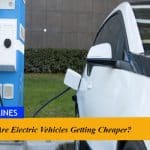According to Cox Automotive, the most significant factor preventing consumers from buying EVs (Electric Vehicles) is the issue of price. By June this year, the average cost of an EV in America was $66,997, 14% more than a year before. Hold-ups in supply chains and hot inflation were two central reasons. The good news, says John Bozzella of the Alliance for Automotive Innovation, is that the elevated prices are “Partly due to supply chain issues”, which could be transitory. He goes on to say that, due to improvements made in battery construction, it’s becoming more and more possible to produce lower-priced EVs.
One advantage of buying an EV in the US has been the $7,500 federal tax credit that goes to consumers, but such financial assistance was aimed toward lower-income consumers, thus it only applied to EVs priced lower than $55,000 (unless they were larger-sized) and to buyers with income below a certain level. Carmakers were motivated to produce lower-cost models in order to be able to offer the tax credits, but the most popular EV in the nation – the Tesla Model Y SUV – actually benefited from the tax credit.
“To proliferate EVs, they need to cost less and be accessible to more consumers, either by price and/or incentives”, says Michelle Krebs of Cox Automotive. In August, there was official talk of extending the tax credit beyond the limit of 200,000units per manufacturer, and US senators also wanted to set caps on EV prices. Let’s take a closer look at how both EV manufacturers and various government initiatives are helping to drive the popularity of EVs, and how such an industry growth spurt may affect the online trading prices of top EV manufacturers.
Headwinds
In order to offer EVS at lower prices, manufacturers have to find a way to keep sufficient funds coming in, which hasn’t been easy in the environment of high-interest rates, high commodity prices, high energy costs, and parts shortages. Rivian said in July that it would have to lay off 6% of its workforce to keep costs down. Canoo was at such a loss for funds that it seemed almost unable to pay back its debts. In June, Lordstown Motors said they were in “substantial doubt” about whether they had enough capital to keep going another year.
As to Tesla, they closed down its premises in San Mateo, California in June at the expense of 229 employees. Tesla had suffered as a result of the Shanghai lockdowns that forced their most important factory to close down for several weeks. CEO Elon Musk’s response was to institute a hiring freeze while also hiking up the prices of key Tesla models. It’s expected that the concrete financial results of the hikes will only be evident in the second half of the year. Tesla did, however, also focus on lowering costs by re-installing the Enhanced Autopilot feature on many of their vehicles, which is more affordable than their Full Self-Driving Package ($6,000 as opposed to $12,000). Despite its challenges, Tesla controls 66% of the EV market in the USA and also produces Europe’s most loved EV – the Tesla Model 3.
The Journey So far
At mid-year, demand for EVs was strong worldwide, and 13% more battery-powered cars had been sold in Q2 than in Q1. In June, the total number of EVs on roads around the world exceeded 20 million (compared with only one million six years ago). There is also the potential to develop EV markets in Mexico, Southeast Asia, India, and Brazil. At the same time as all this, note that the number of new EVs sold in Q2 2022 was 20% less than the number sold in the same quarter a year before. Also, just to gain perspective, by the end of 2022, only 2% of the passenger vehicles in the world will be electric. There is still much progress to be made in fostering the growth of the global EV market, and a big part of that must be done by reducing prices. We see evidence for this in the fact that China’s most popular EV for the first half of 2022 was the Hongguang Mini, which weighs only 560 kg and sells for only $4,700. In India too, EVs have made inroads in the smaller three-wheel vehicle category.
The Road Ahead
As the second half of 2022 got underway, the Nissan Leaf was one of the most modestly priced EVs on the market, starting from $28,375 but also offering a 147-horsepower motor and a generous range of driver assistance features. The Mazda MX-30 is another good option, priced from $34,695 and equipped with rain-sensing wipers and blind-spot monitoring. The Hyundai Kona EV SL, at an affordable $35,225, has an imposing range of 258 miles. If your CFD trading portfolio includes any of these top EV brands, it’s worth keeping an eye on current and upcoming market performance so that you can make more well-rounded online trading decisions.


